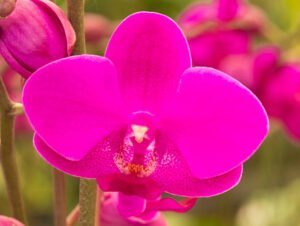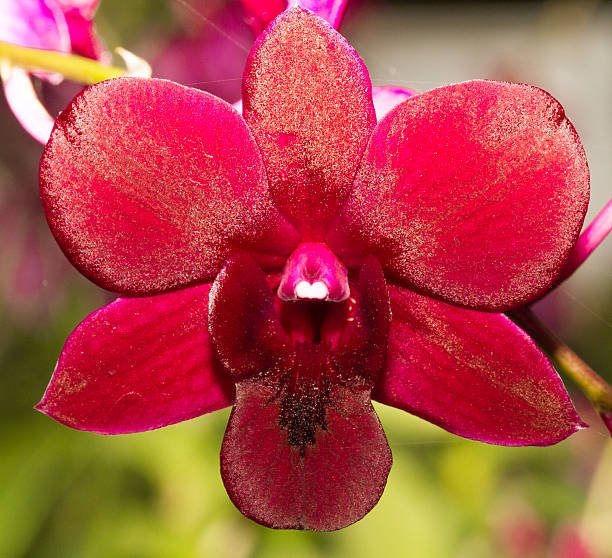Blood orchid flower
The stunning blossoms of the blood orchid flower, which come in a variety of blood-red colours, make it a sought-after plant. The jungles of Borneo are home to this unique plant. Is it simple to maintain a blood orchid? As a gardener, of course, you’ll have a wide variety of plants to choose from. Blood orchid is one of its highlights.
It’s understandable that you’d want to include this flower in your yard, given its stunning appearance. But when it comes to caring for these kinds of flowers, it might be a challenge.

Orchidaceae is a family of orchids that includes blood orchids. Flower colours range from deep pink to blood-red or even brownish-red, depending on the kind.
History
Throughout history, this flower has been the focus of several stories and legends. It is commonly grown during Easter to symbolise the blood of Christ since it is thought to signify death and permanence. Additionally, the plant is often represented in representations of the goddess of death, Artemis. Tribes are said to perform ceremonies using blood crimson orchids.
A Blood Orchid Flower’s Care
It is possible to care for this species of orchid in the same way as most other orchids. Orchids, when properly cared for, may survive for decades. Just don’t let them dry out entirely between waterings; they’re simple to care for. Here are a few pointers to assist you care for a blood orchid flower.
Light
There is no need to plant blood orchids in a dark area, although they do not need much light. This kind of plant prefers light that is filtered by trees and other foliage. To keep them safe throughout the summer, you must keep them away of direct sunlight. Indoors, blood orchids are more common, however they may be grown outside in USDA zones 5 to 9.
Watering
Blood orchid flowers should be watered regularly, but not excessively. The simplest method to tell whether the soil is wet or dry is to just push your finger into it and see if it responds. It is recommended that you use a small dish to soak your orchid for a few minutes before watering it from the top.
Humidity
If your home is too dry, use an ultrasonic humidifier or spritz the leaves of your blood orchid flower plant often to maintain a humidity level between 40% and 50%.
Temperature
When growing blood orchid flowers, be sure to keep them near a window where they will get enough of sunshine and a comfortable temperature between 70 and 80 degrees Fahrenheit. Keep your orchids out of the cold if the temperature is expected to dip below 55°F. The chilly draughts from a window or air conditioner might damage your blood orchid blossom.
Fertilization
During the growth season, fertilize no more than once every two weeks. Normal plant food may be diluted to half strength with orchid fertilizer. Even as an orchid fertilizer, used coffee grounds may be used.
Bacteria and fungi
Many pests and diseases are unlikely to impact blood orchid flowers. Before the insects spread to other sections of the plant, it is important to eliminate them as soon as possible. Aphids, mealybugs, and spider mites are among the most prevalent pests that plague crops. Both neem oil and insecticidal spray may be used to eliminate these pests.
Read About: How long take-off dog from new sod?
Soil
It is advisable to use peat moss, sphagnum, and perlite as the best soil for the blood orchid. You should be able to grow your plant in the pot that you got it in the vast majority of circumstances. A soil pH of between 5.5 and 6.5 is ideal for the blood orchid bloom. Your plant needs slightly acidic soil to grow.
Pruning
Beautiful and long-lasting, blood orchid flowers are a must-have in any garden. After the original blooms have faded, they develop new ones. Just above the leaves, you may remove the old blooms from your orchids. Plants that have lost their blooming stem might focus on producing new flowers or bolstering their root systems.
Conclusion
Prior to making a purchase of an orchid, ensure sure there are no visible signs of insects or illness. Two to three thick strong stems and a lot of healthy roots are also required. When you get your Orchid, take care not to harm any of the delicate parts by gently removing the packaging.
Orchids are popular because of their brightly coloured blossoms. A wide variety of hues and sizes may be found when it comes to orchids. No matter what colour scheme you choose, orchids will add a touch of elegance to any room.

[…] How to grow and care blood orchid flower? […]